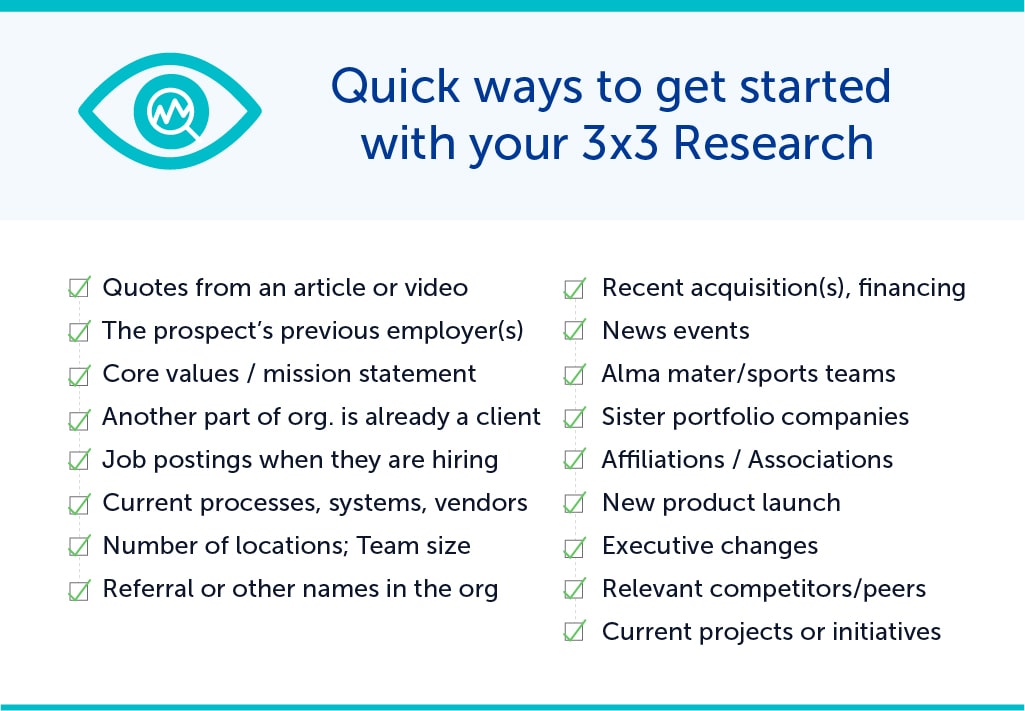We have all heard of pre-call research before. The reason we coined the term 3×3 research is that if people spend too much time on pre-call research, they turn into librarians.
People who don’t do the pre-call research at all, let’s call them cowboys. They just shoot from the hip, ask questions later. So, cowboys are like – high activity level, no research.
Now consider librarians. They have way too much research, low activity levels.
You need a healthy blend. We call them snipers. Every company has them. They are the people who work smarter, not harder.
Less activity than the cowboys, higher than the librarians, yet their results are usually double or triple what their peers are related to generating top-of-funnel opportunities. How are they doing it? They find three points on the company or contact in three minutes of research. That’s where the 3×3 research concept comes into play.
What is 3×3 Research or 3×3 Prospecting?
Three key points on the company and/or on the contact in less than three minutes; also known as “pre-call research”.
These are precisely the buckets of contextual information you’re looking for:

You want things like they’re hiring and posting jobs, a common investor with one of your customers, there’s a sister portfolio company to one of your customers, or they posted something on LinkedIn.
If you follow the 3×3 research guidelines, you’ll still be reaching out to your prospect quickly, but also with enough context to make a valuable call.
The most important things to look for are trigger events that indicate a major change in prospects’ data, their organization, or their industry.
You should keep an eye out for the following three types of events:
- Personal: Promotions, changes in the company, social media engagement
- Company: Leadership changes, product launches, press releases
- Industry: Regulatory changes, new competitors
Now that you know what kind of information makes a productive call, let’s take a look at how to find the required data.
Sources of 3×3 Research
Many sales reps are good at the research part to drive a productive sales call. But what matters in the 3×3 research model is that they need to do it in less time.
One of the big things is the sales reps from most of the organizations have not been trained and enabled on how to do this quickly. They can do it, but it’s time-intensive.
Here are some of the sources for your 3×3 research:
- Your CRM & marketing leads
- Google searches
- LinkedIn, Twitter, Blogs
- Sales intelligence tools like Owler, SalesIntel, ZoomInfo, Seamless, LeadIQ
- Chrome Extensions like HG Focus, RevDriver, Hoovers, Ghostery, BuiltWith
- Account website
- Industry publications
- Press releases
- Analyst reports / public filings
- Conversations with employees in that organization
The right rubric or the combination of 3×3 differs from one company to the next, but once you crack the code on it, it makes a difference.
Make Smart Use of Google
Google, without a doubt, is the largest search engine. But, there’s so much more you can do to narrow your search to save time.
For instance, you go on Google, and you do a Boolean search with quotation marks around a name, and then the company name, and then after that, you hit enter. If you are dealing with a CEO, there’s going to be a lot of information, usually a lot of stuff online. If you are dealing with someone lower, not so much.
You can go to search tools, it’s in the upper-right and click on tools.
Then you can change the time horizon. You could say, “Just show me results from the past month. Just show me results from the past week or the past year.” It’s not only the way to find the information about your prospect, but it can increase your speed.
Save Time Using Direct Dials
On average, a typical sales rep makes 52 sales calls every day. How many of those phone calls result in actual conversations? And how many of those encounters result in a sales step forward? The average conversion rate from a call is 9%.
Only 23% of the interactions result in a scheduled appointment. As the sales process advances, the percentage of clients that proceed improves, but only because the pool of prospects who are still interested diminishes considerably.
Studies show that an SDR is 46% more likely to connect when dialed directly. At the VP level, the chance of connecting increases by a whopping 147%. As a result, you’ll have a better probability of increasing revenue over time.
With the highest number of human-verified work mobile numbers available, SalesIntel has the most comprehensive coverage on the market. To ensure data accuracy, our research team verifies mobile numbers every 90 days. According to a ScaleX study, sales reps who use SalesIntel work mobile numbers are 7x more likely to contact prospects than those who use switchboards or direct desk phones.
Read About – Sites Like Zoominfo
Don’t Fall into the Endless Pre-Call Research Loop
A sales job is one part detective work. You have to use all the clues, information, and resources at your disposal. The 3×3 method can help with any prospecting function and ensures you don’t fall into the trap of endless research. While knowing a lot about a prospect is a valuable tool, the more efficient you can be with your selling activities, the more successful you’ll be.
With SalesIntel, pre-call research is a whole lot easier to get you ahead in the game. You’ll already start with company info on size, tech stack, contact details, and more to cut down on research time and get right into a productive sales call.
SalesIntel helps sales reps conduct tailored prospect searches and make productive sales calls. Our data points include firmographics, technographic data, direct dials, Buyer Intent data, and more. You can also use the data enrichment feature to enrich your missing data points in just a few clicks.




